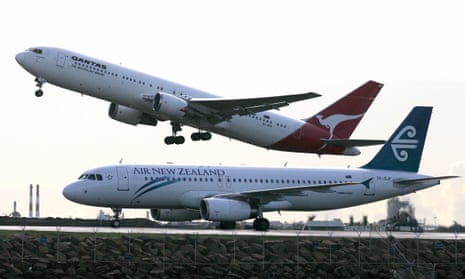A Trans-Tasman bubble allowing travel between Australia and New Zealand is “on pause” after new Covid-19 outbreaks, and may be delayed until after NZ’s general election, possibly until next year.
Australia’s minister for the Pacific, Alex Hawke, said both Australia and New Zealand remained committed to establishing a travel bubble as soon as it could be safely done, but that while work was continuing on the logistics of a travel regime, it was not imminent.
“The Trans-Tasman bubble’s on pause for a little bit, but as soon as we are able to get policy commitment to it, we want to be administratively ready. New Zealand has indicated that there will be a short pause on that but they are committed to the outcome,” Hawke told a Pacific press briefing.
After early reports a regime allowing travel between Australia and New Zealand could be in place by September, it may now be delayed until after New Zealand’s uncertain general election.
Scheduled for 19 September, the election itself may now be postponed, after new Covid-19 outbreaks in the country’s largest city.
The opposition National party has called for the poll to be delayed until November, possibly even next year, arguing voting could not be “fair and just” under lockdown conditions. A decision is expected next week.
“The NZ election is, of course, an issue,” Hawke said. “They might take some time to get through that, which of course disrupts government, and so that [travel bubble] may be off until after the election.”
Both Australia and New Zealand are dealing with renewed outbreaks in major cities.
In Victoria, Australia, a recent surge in cases – in excess of 700 some days – has forced the city of Melbourne back into lockdown.
In New Zealand a smaller outbreak, but coming after more than 100 days without a new infection in the community, has put Auckland into a similar shutdown.
A broader pan-Pacific travel bubble has been mooted, but appears likely to commence later than Australia’s arrangement with New Zealand, despite a number of Pacific countries remaining Covid-free.
Australia is in discussions with Fiji about opening two-way travel between the two countries, but Hawke said no other Pacific country had yet expressed an interest in opening their borders to travellers from Australia.
“Other countries so far have not indicated their willingness to have a bubble yet and we understand that. But as people want to partner on this, we’re engaging with them,” Hawke said.
New Zealand has been in talks with the Cook Islands, but the recent Auckland outbreak has likely delayed that also.
Hawke said Australia was working with Pacific countries to restart its Pacific Labour Mobility Scheme, a major driver of remittances across the region, which are forecast to decline by 13% in 2020.
“We see our Pacific labour mobility scheme as very important in the period ahead to continue and ideally expand,” he said.
“I would just urge caution on the term expansion. We would like to see [the program] grow but with Covid and restrictions in place, that could be challenging.”
Australia has announced a trial seasonal workers program with Vanuatu, bringing 170 farm workers to the Northern Territory to pick mangoes during the summer harvest.
The Pacific region, having avoided the health crisis wrought by the pandemic, appears potentially poised on the precipice of a new, larger wave of fresh infections.
The number of cases in the most populous Melanesian country, PNG, has jumped from just 11 less than a month ago, to 287. Three people have died.
But the number of actual cases is believed to be many times higher. Testing has been severely limited – just 11,000 tests have been carried out across the whole country during the entire pandemic – and the spread of the disease is believed to be far greater.
Despite the infection rate climbing, the PNG government has lifted the lockdown of the capital, Port Moresby – schools have re-opened and public transport re-started. For many in the capital, social distancing is impossible, with large extra-familial groups living in close confines, while 40% of the city is without access to running water.
French Polynesia, a month after abolishing mandatory quarantine for international arrivals, has seen a significant jump from the low number of cases. It now has 77 cases in its second wave, for a total number of 139.
Despite the surge in cases, the French Polynesian president, Edouard Fritch, and the French high commissioner, Dominique Sorain, has said there will not be another lockdown. Fritch said the spread of the virus was due not to overseas arrivals, but irresponsible behaviour.
